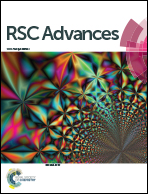Zinc(ii) and cadmium(ii) amorphous metal–organic frameworks (aMOFs): study of activation process and high-pressure adsorption of greenhouse gases†
Abstract
Two novel amorphous metal–organic frameworks (aMOFs) with chemical composition {[Zn2(MTA)]·4H2O·3DMF}n (UPJS-13) and {[Cd2(MTA)]·5H2O·4DMF}n (UPJS-14) built from Zn(II) and Cd(II) ions and extended tetrahedral tetraazo-tetracarboxylic acid (H4MTA) as a linker were prepared and characterised. Nitrogen adsorption measurements were performed on as-synthesized (AS), ethanol exchanged (EX) and freeze-dried (FD) materials at different activation temperatures of 60, 80, 100, 120, 150 and 200 °C to obtain the best textural properties. The largest surface areas of 830 m2 g−1 for UPJS-13 (FD) and 1057 m2 g−1 for UPJS-14 (FD) were calculated from the nitrogen adsorption isotherms for freeze-dried materials activated at mild activation temperature (80 °C). Subsequently, the prepared compounds were tested as adsorbents of greenhouse gases, carbon dioxide and methane, measured at high pressures. The maximal adsorption capacities were 30.01 wt% CO2 and 4.84 wt% CH4 for UPJS-13 (FD) and 24.56 wt% CO2 and 6.38 wt% CH4 for UPJS-14 (FD) at 20 bar and 30 °C.



 Please wait while we load your content...
Please wait while we load your content...